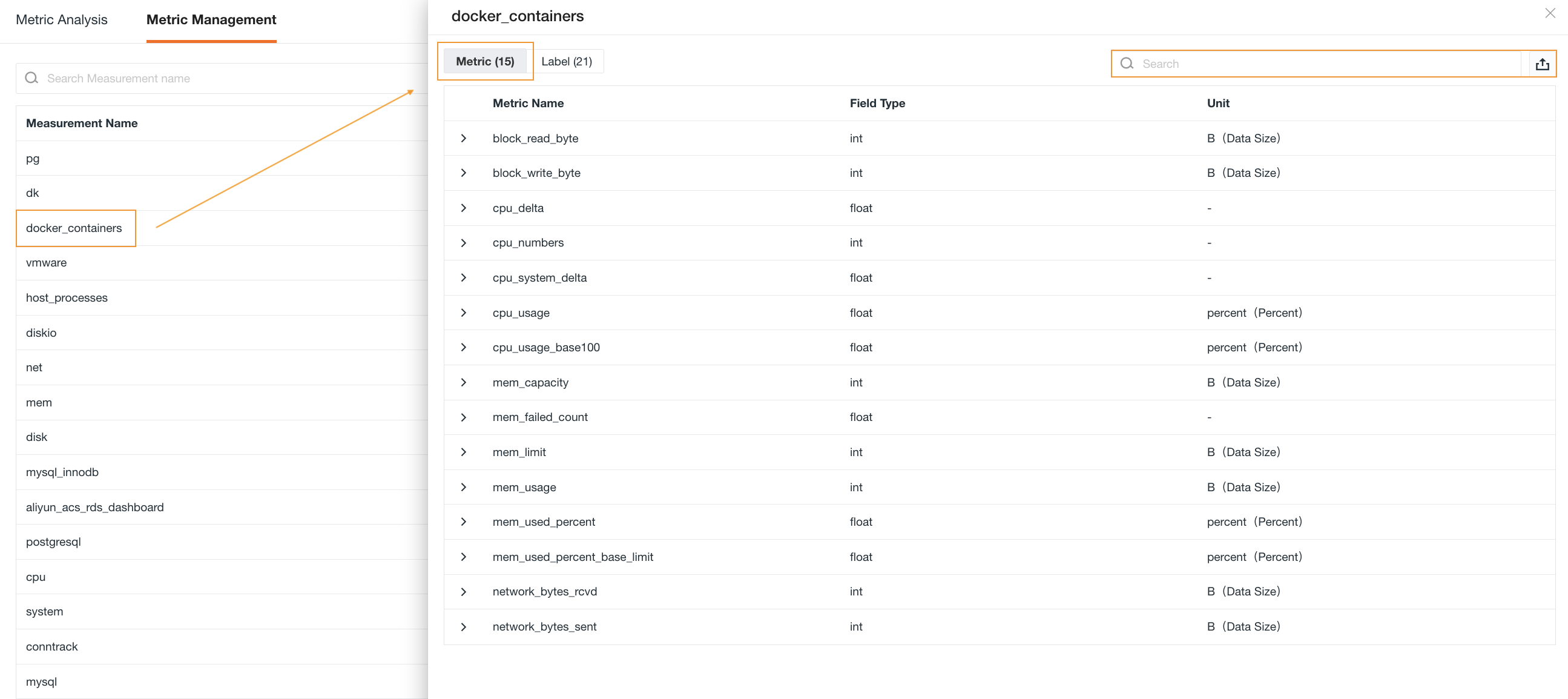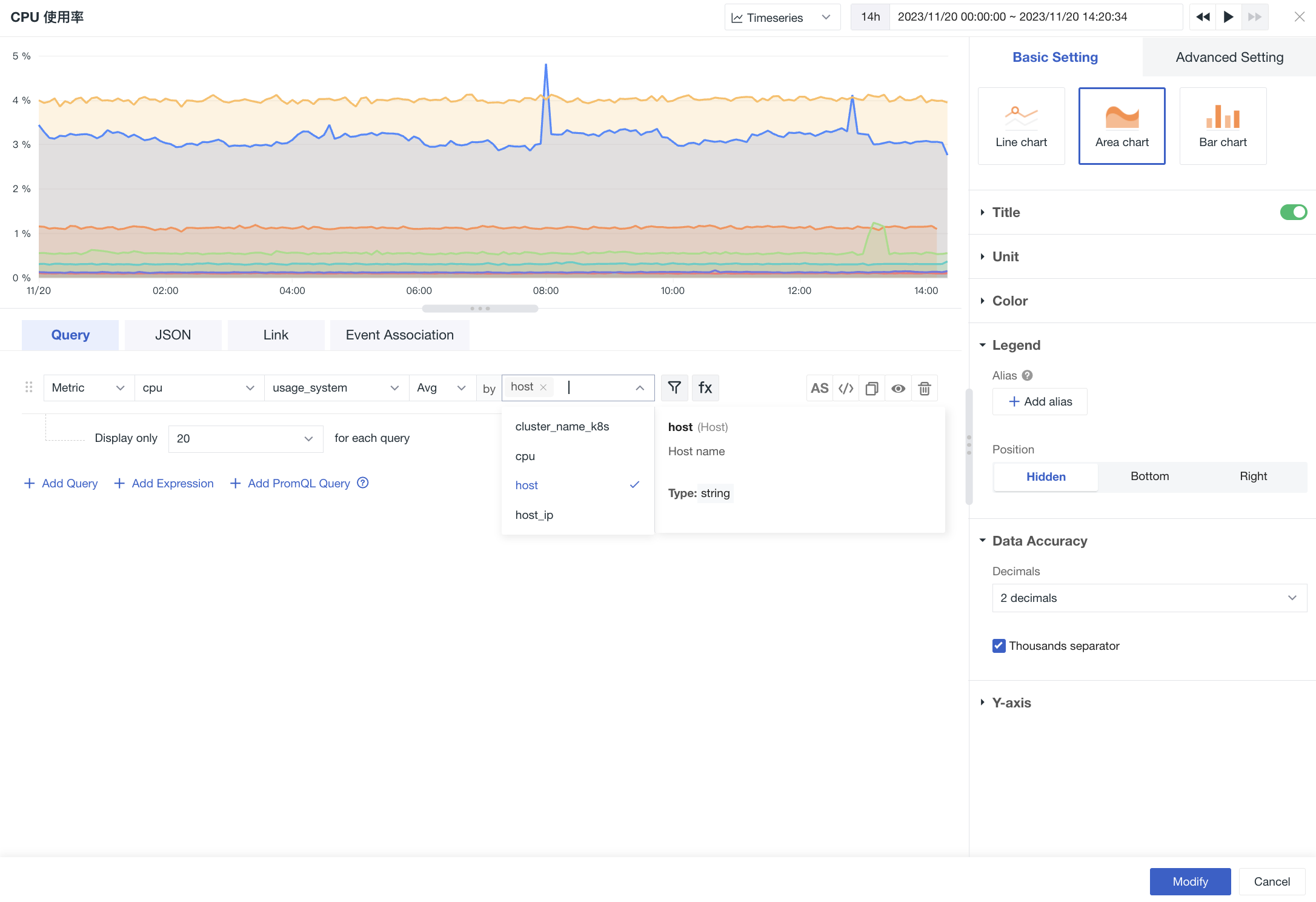Metrics Management¶
After completing the collection of metrics data, you can view all reported measurements as well as related metrics, labels, time series counts, and data storage strategies in Workspace > Metrics Management.
Measurement¶
A measurement is a collection of metrics of the same type; one measurement can include multiple metrics and labels. Clicking on a measurement allows you to see all available metrics and labels under that measurement in the details page, and you can quickly locate desired content through fuzzy search.
Metrics¶
Metrics can help you quickly understand the overall system performance, such as server CPU usage, website load times, remaining disk space, etc.
Metrics consist of a metric name and a metric value, where the metric name is an alias for the metric, and the metric value is the specific numerical value collected at the time. In Workspace > Metrics Management, clicking on the measurement name allows you to view the corresponding list of metrics, including metric names, field types, units, and other detailed information.
- Through , search for relevant metrics based on keywords;
- Through , export the metrics list as a CSV file to your local machine.
- Click the icon under Actions to perform one-click metric analysis;
- Click to expand the metric data, allowing editing of metric configurations.
Editing Metrics¶
In Metrics Management, you can view all metrics reported to Guance, including metric names, field types, units, and descriptions, and customize the editing of the units and descriptions of the metrics. After saving, these changes will be applied in chart queries.
Permissions and Priority
- Metric details can only be edited by standard members or higher permissions;
- Custom-added units and descriptions in Metrics Management have a higher priority than default collected data. For example, if the unit is changed from
BtoGB, the unit on the chart during scene-based chart queries will display asGB.
Use Cases¶
When querying metrics, you can more conveniently query and analyze data by viewing the metric name, field type, unit, and description. For instance, when performing chart queries or detecting metrics in monitors, you can view real-time detailed information about the metrics.
Labels¶
Labels can help you associate data from different sources. {{ custom_key.brand_name }} supports reporting all metrics, logs, and APM data uniformly to the workspace. By tagging collected data with the same labels, you can perform correlation analyses to quickly identify and resolve potential risks.
Labels are collections used to identify the properties of data points, consisting of label names and label values. A single data point can have multiple labels. In Workspace > Metrics Management, clicking on the measurement name allows you to view the corresponding label list, including label names, statistics of label values, and detailed descriptions.
- Click to search for related labels based on keywords;
- Click to export the label list as a CSV file to your local machine;
Use Cases¶
When querying metrics, you can quickly understand their meanings by viewing label descriptions. For example, when performing chart queries or detecting metrics in monitors, you can view the real-time description information of the labels. Guance provides default system fields/label explanations, which you can replace according to needs in Field Management.
Time Series¶
In the current workspace, the dynamically calculated number of combinations of metric data based on tags. In Guance, time series are composed of metrics, labels (fields), and data retention durations. Among them, “metrics” combined with “tags (fields)” serve as the primary key for data storage.
| Term | Description |
|---|---|
| Database | Databases. |
| Measurement | The measurement, which can be understood as a table in MySQL. |
| Field | The metric, key-value pairs in InfluxDB that record actual data (mandatory in InfluxDB and not indexed). |
| Field Set | A collection of Field key-value pairs. |
| Field Key | The key in the Field key-value pair. |
| Field Value | The value in the Field key-value pair (the actual data). |
| Tag | The tag, used to describe the key-value pair of Fields (optional in InfluxDB and indexed). |
| Tag Set | A collection of Tag key-value pairs. |
| Tag Key | The key in the Tag key-value pair. |
| Tag Value | The value in the Tag key-value pair. |
| TimeStamp | The date and time associated with the data point. |
| Retention Policy | Data storage duration (data retention strategy). |
| Series | Time series are composed of Retention Policy, Measurement, and Tag Set. |
Metrics Storage Strategy¶
The metrics storage strategy is divided into two types:
- Global settings at the metrics workspace level;
- Custom settings for specific measurements.
Modify Strategy¶
Custom settings for measurements take precedence over global settings for metrics. That is, after setting a custom data retention strategy for a measurement, changing the global settings for metrics does not affect the data retention strategy for that measurement.
Note
- After modifying the data retention strategy for a measurement in Metrics Management, the corresponding measurement data saved in the global workspace strategy will be deleted and cannot be recovered. Please proceed with caution. If the data retention strategy for the measurement is modified again, the data under the previous strategy will also be deleted.
- After modifying the data retention strategy for a measurement, the data for that measurement will be stored separately. At this point, changing the global data retention strategy duration for workspace metrics will not change the storage strategy duration for that measurement.
- After modifying the data retention strategy for a measurement and reverting it to the global default metrics data retention strategy duration, the measurement will be re-stored in the global database. At this point, changing the global data retention strategy duration for workspace metrics will synchronously change the storage strategy duration for that measurement.
- After modifying the data retention strategy for a measurement, even if the global data retention strategy duration for workspace metrics and the storage strategy duration for the measurement are set to be consistent, the data for that measurement will still be stored separately and will not be stored in the global database.
Global Metrics Settings¶
In Manage > Settings > Risky Operations, you can view the global data retention strategy for the metrics workspace. The default metric data retention is 7 days, including options like 3 days, 7 days, 14 days, 30 days, 180 days, and 360 days.
For more details, refer to Data Storage Strategy.
Custom Measurement Settings¶
In Metrics Management, you can view and customize the data retention strategy for measurements.
Click the button in the Actions column to customize the data retention strategy for the measurement. Options include: 3 days, 7 days, 14 days, 30 days, 180 days, and 360 days. If no customization is done, it defaults to being consistent with the global data retention strategy for metrics.
Note
- Measurement data retention strategies can only be configured by workspace owners, and Free Plan does not support custom data retention strategies;
- After modifying the data retention strategy duration for a measurement, the data under the previous strategy will also be deleted and cannot be recovered.








